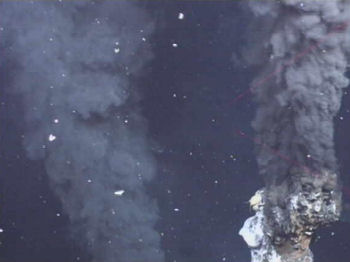Citizens of the deep
Just as plants use sunlight energy to make organic matter from inorganic carbon, these bacteria use chemical energy in the mineral-rich waters erupting from hydrothermal vents. This trick is called chemosynthesis, rather than photosynthesis. The chemosynthetic microbes provide food for some animals, which in turn provide food for other animals - creating a whole food chain in the dark depths.
The recipe for chemosynthesis has three basic ingredients. The first is inorganic carbon, which forms the building blocks for the organic molecules that are the end-product of the process. Chemosynthetic bacteria also need hydrogen sulphide, or sometimes methane, as the energy source to build those molecules. And finally they usually need oxygen to make the reaction work.
All these ingredients are abundant at deep-sea vents. There is normally plenty of inorganic carbon and oxygen dissolved in seawater. And the hot fluids erupting from the vents are usually rich in hydrogen sulphide and methane. In the case of the tubeworms, the chemosynthetic bacteria live inside the bodies of the animals in a close partnership with them. The tubeworm supplies the bacteria with the raw materials they need to grow - and the growing bacteria nourish the tubeworm in return.

This cosy arrangement is very efficient - in fact, the tubeworms and their bacteria turn inorganic carbon into organic matter as efficiently as plants on land. But although this deal allows the tubeworms to forgo the need for mouths or guts, they still need to supply the bacteria inside them with the ingredients for chemosynthesis.
For the tubeworms, getting oxygen to their bacteria is relatively easy. The worms obtain oxygen from seawater through their bright-red plumes. The worm's plume is riddled with tiny blood vessels that carry blood rich in haemoglobin - the same kind of molecule that carries oxygen in our own blood. This haemoglobin-rich blood gives the plume of the worm its bright-red color. Just as the worm supplies its own cells with oxygen via its blood supply, so it can deliver oxygen to the bacteria living inside its body.
Supplying the bacteria with inorganic carbon is no problem either. Like any other animal, the worm produces carbon dioxide as a by-product of the respiration reactions taking place in all its cells. This inorganic carbon travels around the blood in dissolved form to the bacteria that need it. And the worm tops up the demands of the bacteria for this ingredient with yet more inorganic carbon from seawater.
But supplying hydrogen sulphide - the energy source for the bacteria - is more tricky. There is plenty in the mineral-rich water gushing from the vents, but hydrogen sulphide is poisonous to most creatures. It poisons haemoglobin and prevents it from carrying oxygen. The tubeworms, however, have evolved unusual hemoglobin molecules. Perhaps uniquely in the animal kingdom, their hemoglobin can carry oxygen and sulphide together safely. This remarkable molecule carries the sulphide from the environment to the bacteria inside the worm that need it.

Not all animals at vents and seeps have chemosynthetic bacteria growing inside them, however. There are also free-living bacteria that grow just about anywhere they can around the vents. Colonies of these bacteria sometimes form visible mats, covering patches of the seafloor in a fuzzy coating that wafts in the currents. Some animals, such as vent limpets, graze on these free-living bacteria.
Bacteria also grow on the outside of animals, such as vent shrimp, which may feed on the microbial gardens that festoon their bodies. And rather than feeding on bacteria, there are also predatory and scavenger species, such as vent crabs that nip the plumes of tubeworms or even snare passing shrimp.
Page 1: A golden age of exploration
Page 2: Secret ingredients of life at vents
Page 3: Life finds a way
Page 4: Island-hopping in the abyss
Page 5: Twilight of the Gods
Science
Find out more about the Cayman Trough, undersea volcanoes, deep-sea vents,
and the inhabitants of the abyss.
What are we investigating?


